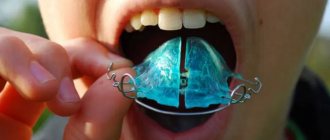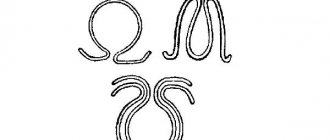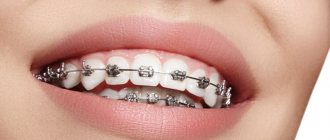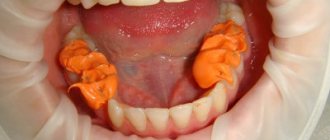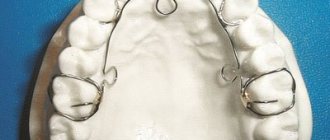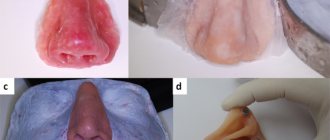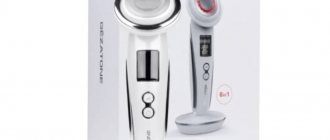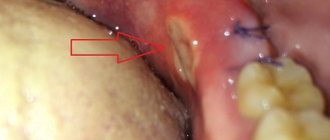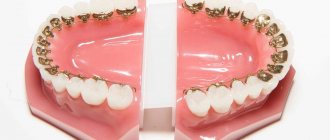To correct pathologies and anomalies of individual teeth and the bite as a whole, various orthodontic systems are used. Among them, functional devices play an important role, thanks to which it is possible to correct a variety of malocclusion pathologies and give the patient a beautiful smile.
general description
Functional orthodontic appliances are designed as devices with an inclined plane and a bite plate. Thanks to this design, pressure can be concentrated on selective teeth and thereby provoke their movement into a given position. The device begins to function only when the teeth are closed, and its effectiveness depends on the intensity of contraction of the masticatory muscles. The stronger the contraction, the more pressure is placed on the teeth.
Orthodontic structures of this type are removable and non-removable. The choice of design and the duration of its wearing depends on the type of pathology and its severity. Removable ones include Bynin's mouthguard and Katz's bite block. The non-removable ones include a Schwartz mouth guard, an apparatus and a Kurlyandsky crown. Modern orthodontics also has other functional devices, which will be discussed in detail below.
Treatment
Treatment of orthodontic anomalies with Bynin's mouthguard takes place in several steps .
The first step is to prepare the dentition for wearing the device. To do this, a complete sanitation of the oral cavity is carried out: the roots of damaged teeth are removed, problem areas are restored and dental plaque is removed.
After correcting the dentition, they begin the manufacturing stage, and then the actual treatment.
Manufacturing stages
Making a mouthguard begins with taking impressions. Despite the fact that the device is single-jaw, impressions are taken from both the lower and upper jaws .
To obtain accurate impressions, plaster or silicone-based elastic impression compounds are used, as well as special impression trays that allow the impressions to be secured in detail.
Elastic masses are preferable in this case, as they give a more accurate result.
Next, the process follows the proven algorithm:
- Based on the casts obtained, working models of the jaws are made .
To make a model of the upper jaw, only plaster is used. When forming the lower jaw, a combined approach is used: the alveolar ridge area is cast from plaster, and the teeth are cast from low-melting metal. - After the working model is completely ready, the lower jaw is covered with a plate of modeling wax . In this case, the strip should completely cover the entire height of the tooth, but not extend to the gum line. The thickness of the wax coating is no more than 1.2 mm.
- After applying the wax, it is given the shape of the dentition, and then they begin to install the inclined plane .
Once the plane is established, the wax model is sent to the patient for fitting. The degree of interaction between the inclined plane and the upper teeth, as well as the alignment of the enamel surface with the base of the aligner, is checked directly in the patient’s mouth. - If necessary, make appropriate adjustments and begin making a mouthguard , for which it is placed in a special device, where the wax on the model gradually melts and is replaced by white plastic.
- The resulting mouthguard is once again tried on the patient and its finishing is carried out : polishing and grinding.
- Then, the patient is taught to put it on correctly . Typically, the initial installation of the structure is carried out by a doctor, explaining his actions step by step.
How the process of making an orthodontic mouth guard occurs, watch the video:
How is the correction made?
Treatment with this device requires regular correction, which is performed once a week or 10 days.
This tactic is explained by the fact that during this period the upper teeth begin to deviate forward and the inclined plane ceases to exert the necessary pressure on them.
The device is corrected by grinding the surface of the inclined plane until the necessary interaction between the device and the upper dentition is achieved.
As a result of such actions, the cutters again begin to slide along the inclined plane.
In what cases the pink Myobrace Starter trainer is used, you will learn from the following material.
In this article we will tell you how mesial bite is corrected surgically.
Here https://orto-info.ru/sistemyi-vyiravnivaniya-zubov/kappyi-elayneryi/chto-takoe-invisalign.html you will find reviews about the effectiveness of using the Invisalign aligner.
Duration of therapy
The treatment period for each case will be individual.
With minimal deviations of the upper teeth at the beginning of the mixed dentition, such a device can help correct the situation within 4 months. Correction of a pronounced abnormal bite during the period of teeth change will take from 1 to 1.5 years .
It should be taken into account that irregular use of the device or non-compliance with wearing time can greatly increase this period.
Correcting occlusion in a permanent dentition takes much longer. As a rule, even a small change in the position of single teeth will require long-term treatment, which can last from 1.5 to 3 years .
Features of the Katz bite block
The Katz bite block is a palatal structure made of plastic. In the area of the lateral teeth it is in close contact with their cervical part, and in the anterior area it is distant from them. There are 4 metal hooks extending from the front of the device. They are thrown over the edges of the four upper central teeth.
The part of the device in the area of contact with the front teeth is made in the form of an inclined plane. It is designed in such a way that the teeth slide off it and thereby gradually move forward. The structure is attached to the upper jaw on the premolars. For this purpose, special fastenings are used - clasps. The plate does not adhere to the anterior zone of the palate, so the support falls on the front teeth.
The principle of operation of the plate is to use the pressure that is created during the work of the masticatory muscles. Thanks to a well-thought-out design, when the jaws are closed, the main pressure falls on the front area of the dentition. Muscle traction, which occurs due to the forced unusual positioning of the jaw, also affects movement.
If certain conditions are met, the plate can be used to correct the entire lower dentition. To achieve this, you need to keep your jaw in a certain position - slightly extended and pulled down. The muscles will constantly tense, and the jaw will gradually shift in the required direction. Overall, this orthodontic plate is designed to correct prognathia. It works comprehensively, acting in two different directions at once:
- sagittal – mesial displacement of the teeth and the lower jaw as a whole occurs;
- vertical - the front teeth are shortened, and the lateral ones are lengthened, this happens in both rows at the same time.
How does it work?
Tight fixation of the frame ensures constant impact on problem units, due to which their movement occurs. This solution makes it possible to accurately select the force of influence and predict the result of the correction.
An inclined plane located perpendicular to them takes part in correcting the teeth of the upper jaw. The force of pressure is the contraction of the jaw muscles.
Upon correction of the anterior teeth of the upper jaw, it is necessary to reduce their contact with the inclined surface, so it is important for the patient to regularly visit the orthodontist to adjust the mechanism.
Dr. Schwartz's equipment
The Schwartz mouth guard is a permanent orthodontic appliance. It is performed with an inclined plane on the cutting edges of the six front teeth of the lower row. Using it, the increased, abnormal development of the lower jaw in the central zone is inhibited, and at the same time the upper central teeth are brought forward.
The Schwartz apparatus is made from impressions individually for each patient. It reliably holds the front teeth in a constant position, so they do not move during correction. The device is used when it is necessary to move the upper teeth, which most often gives excellent results.
Schwartz's record differs from Katz's similar equipment. The main feature is that instead of reversible clasps, it is complemented by a vestibular retraction arch. To activate it, special loops are provided. Isolation is done behind the teeth being corrected. The plate is supplemented with an inclined plastic plane.
Based on the severity of the inclination of the axis of the teeth to be moved, the arch can be placed on the labial part of the crowns closer to the cutting edge, neck or in the middle. If it is necessary to expand the dentition at the same time, a screw is added to the structure. I would also like to say something about the Schwartz clasp. This is the name of a special fastening made of wire 0.6-0.7 mm thick, designed for fixing orthodontic plates in the mouth.
Indications and contraindications for the use of the Schwartz mouth guard
The use of a Schwartz mouthguard is advisable when eliminating:
- palatal position of the upper jaw incisors - the teeth shift towards the palate due to insufficient space in the dentition;
- mesial bite - a distinctive feature of which is a slight forward movement of the lower jaw.
Contraindications to use of the product are:
- deep bite of 2 and 3 degrees - the dental crowns of the upper jaw incisors overlap the crowns of the lower jaw incisors by more than 5 mm;
- the presence of a sagittal interincisal gap - when the dentitions are closed, there is no contact between their frontal sections
Correction with Bynin mouthguard
Bynina mouth guard is used to correct the position of the front teeth. The upper teeth move in the vestibular direction, and the lower teeth – in the distal direction. This is a single-jaw device that creates low to medium intermaxillary force. It can be used equally successfully for any type of bite to correct dentition. Requires almost 24/7 wearing. It can be removed only if absolutely necessary in order to carry out hygiene procedures or eat.
Structurally, Bynin's mouthguard is a plastic product that is worn on the lower jaw. The product covers the entire row of teeth. The mouthguard is made so that the crown relief is repeated with extreme precision. The structure is practically invisible on the teeth due to its very small thickness - no more than 1.2 mm.
An inclined plane is made in the area of the front teeth to slide the upper crowns and provide pressure. Its width is determined individually. A distinctive feature of the device is the complete absence of auxiliary small parts characteristic of orthodontic structures: arches, processes, hooks.
The mouthguard is made individually for each patient, which allows for maximum effectiveness. The main function is to create constant pressure on the teeth being corrected so that they gradually move in the desired direction. The main operating force, like other devices of this type, is the contraction of the masticatory muscles.
Advantages and disadvantages
This device, despite the simplicity of its design, has a number of certain advantages :
- affordable cost of the product;
- no direct effect on periodontal tissue, which minimizes the risk of inflammation;
- the absence of additional corrective elements, due to which removing and putting on the device does not cause difficulties even during initial use;
- a gentle corrective effect on the dentition, as a result of which addiction occurs quickly;
- There is virtually no discomfort or pain while wearing;
- if necessary, it is possible to remove the mouthguard at any time;
- after complete restoration of occlusion, the mouthguard can be used as a retention device. To do this, you just need to completely grind off the inclined plane and grind the edges.
Bynin mouthguards are used quite rarely, as they have some disadvantages :
- small impact force, allowing to correct only minor deviations in the development of the jaw and dentition;
- This device is removable, so it requires discipline, since a positive result will only be possible if you follow the wearing regime. It is especially difficult to monitor this factor when correcting occlusion in children;
- To ensure constant pressure and quick correction, it is necessary to ensure that the teeth are closed as often as possible. Otherwise, the treatment procedure may take a very long period;
- aligners need to be adjusted frequently to ensure that the inclined plane always puts enough pressure on the upper teeth.
Features of the Kurlyandsky apparatus
The Kurlyandsky apparatus is used to correct palatal anterior teeth. It includes two crowns for the central anterior teeth of the lower jaw. On the side facing the lip, a wire is soldered to them horizontally to cover the six front teeth. On the opposite side there are tubes for fixing the guide plane, which has a curved shape. The material for production is wire.
The device moves the teeth in the sagittal direction. The plane is made removable, this helps to control the progress of the correction. The device is worn constantly, but the inclined plane can be removed at night.
Device classification
Before choosing the type of construction for a specific clinical case, the doctor must assess the general health of the patient’s body, take into account the development of the dental system in accordance with age, the number of teeth that have erupted, and the condition of the periodontal tissues.
Poor installation and fixation of the device in the oral cavity leads to its displacement during therapeutic correction , which prolongs the period of correction and provokes the development of a bad habit of ensuring the stability of the structure in the mouth with the tongue.
Experts divide the entire range of structures for orthodontic treatment into categories:
- directed purpose - preventive, therapeutic, retention (holding);
- technical ability - functional, mechanical, functional-guiding, combined operating principle;
- fastening technique – removable, non-removable, partially removable devices;
- location - extraoral, intraoral on one or both jaws, combined.
If the support fragments are incorrectly selected, various complications can arise, including unwanted movement of the supports under the action of reactive pressure (recoil force). Therefore, the dentist must take the process responsibly.
Correction with Kerbitz vestibular plate
The vestibular plate of Kerbitz is adjacent to the corresponding surface of the teeth to the transitional folds of the mucous membranes. A plate is needed to move the upper row of front teeth in the palatal direction. Due to the thoughtful design, mucous tissues are not injured.
For the cutting edges of the upper incisors, a small plastic step is made in the area of the plate adjacent to the vestibular surface of the crowns. This ensures the stability of the structure and prevents it from slipping. To expand the row from the remaining teeth, a certain distance is maintained.
Reviews
Kappa Schwartz is considered a simple and effective remedy for the treatment of moderate retrusion of the upper anterior teeth.
This anomaly is relatively rare (much less common than protrusion), so there are not so many people who have tried treatment with the Schwartz mouthguard.
If you are one of them, tell us how your treatment with the Schwartz mouthguard ended, and whether any problems arose. Comments can be left at the bottom of this page.
If you find an error, please select a piece of text and press Ctrl+Enter.
Tags: bite correction plates for teeth straightening
Did you like the article? stay tuned
Previous article
Learn more about the positive and negative aspects of the Deflex denture
Next article
The Osamu retainer is an example of the highest quality and effectiveness
Construction and use of the Kraus plate
The Kraus plate is used in open bites to restore the physiological position of the teeth. This pathology usually develops in children if they have the habit of sucking their tongue or have impaired swallowing functions. The device consists of two plates (upper and lower), fastened with pieces of wire. It is fixed between the canines, incisors, and first primary molars.
There is a second design model, which differs fundamentally only in the location of the wire sections. It involves the lateral surface of the last lower molars in the retromolar region. This is done to securely secure the forward jaw. This type is more suitable for correcting distal occlusion in the formative stage, provided that the child has all the teeth.
Wearing rules
The duration of treatment with the Schwartz apparatus depends on the complexity of the pathological abnormalities. According to statistical data from orthodontic practice, the effectiveness of the product is noted already in the first weeks of wear.
The oral position of the elements of the dentition can be changed in an average of 18 months with a mixed dentition. With a fully formed bite, treatment can take up to 36 months.
Remember! If during the first two weeks of correction the effectiveness of the device is not noted, it should be dismantled and a device with active mechanical action installed.
It is important to know that the Schwartz mouthguard should not be worn for too long. This can lead to vertical separation of the upper and lower dentition in the incisor area, as well as provoke dentoalveolar elongation.
The period of wearing a mouthguard does not require special care. It is necessary to perform standard hygiene procedures daily and follow the doctor’s recommendations:
- hygiene procedures twice a day;
- use of rinses after meals;
- avoidance of too hard foods;
- scheduled visits to the orthodontist for follow-up examinations.
Remarkable! For successful orthodontic correction, doctors recommend removing dental plaque once every 2 months, and also trying to use additional hygiene products - herbal decoctions as rinses, pharmaceutical antibacterial solutions, dental floss, brushes, irrigator.
Features of Schonherr's vestibular plate
The Schonherr vestibular plate is used for open and distal bites with protruding incisors and a narrow upper dentition. These pathologies occur in children as a result of a number of habits. For example, if they often suck their thumb, bite their lower lip, or breathe through their mouth.
Pathologies that develop in children due to the above reasons can spontaneously resolve after changing the bite to a permanent one. Therefore, the plate is aimed not only at eliminating bite defects. First of all, the device is used to wean from the listed bad habits. In addition, the plate normalizes the functions of the muscles of the perioral cavity. The device is available in 3 sizes for use by children of different ages.
Main characteristics
Mouth guards are rarely cast from “new silver” (an alloy of copper up to 35%, nickel and zinc up to 45%), and duralumin.
The most common material used in manufacturing is plastic. The prevalence is justified by the affordable cost and ease of use. Plastic aligners are easily removed from the mouth after treatment.
The device is secured to the patient's teeth using cement.
The most important element of the device is an inclined platform, which has an angle of inclination to the longitudinal axis of the dentition element of about 65° and a height of 1.5 to 2 cm.
Correction of the inclined platform at the correction stages is carried out by grinding. This abrasive treatment allows you to eliminate a certain layer of the surface of the product in order to achieve optimal impact on abnormal teeth.
When used exclusively for indications and correctly created, the Schwartz Kappa gives excellent treatment results.
The video provides an overview of the design of the Schwarz sector-cut plate.
Functions of the Katz guide bit
The Katz crown is used to correct palatal inclination of the upper incisors, as well as a protruding jaw with deep incisal overjet. This is a metal crown; an inclined plane made of wire loops extends from its sides and cutting edge. If it is necessary to move several teeth at once, in addition to the Katz guide crown, beams are used that touch their palatal surface. If there is not enough space for free movement, then crowns with expanders are used.
The severity of the separation of rows of teeth affects the effectiveness of the device. The length and angle of linear inclination of the plane also influences. If the overall separation is no more than 4 mm, the teeth will receive the required intensity load only during the chewing process. With greater separation, the pressure will be constant even while the masticatory muscles are at complete rest.
The length of the linear contact of the inclined plane affects the intensity of movement. One tooth in contact with the plane will receive more pressure than several at once. Therefore, the duration of treatment depends on their quantity. The device stops working the moment the lateral teeth begin to contact the inclined plane. Therefore, sometimes crowns are removed, remade and installed again.
The optimal device for a particular case is selected by the orthodontist, taking into account the type and complexity of the pathology. In addition to the devices discussed in the article, others can be used if it is decided that they will give a better effect in treatment. But this is the doctor’s choice, and we suggest you familiarize yourself with the most common malocclusion pathologies to make it easier for you to understand the terms found in the article.
Price
Today, of all functional orthodontic devices, Bynin's mouth guard is the most affordable . This is due to the small set of consumables that are needed for its manufacture.
On average, the price range for this device is 1400 – 3500 rubles . Even in expensive clinics, the cost of its production does not exceed 4,000 rubles.
But when calculating the total amount, it should be taken into account that in addition to manufacturing the device, you will have to pay for regular correction and constant monitoring of the correction process. As a rule, this increases the cost by at least 5 thousand .
Fixed types
Fixed structures include devices that are fixed in the patient’s mouth once and are not removed until the end of treatment. The period of correction with such devices is usually short, and the retention period is long.
Engla
Universal device. It may have three principles of action depending on its purpose:
- springy – works to expand the dental arches in the chewing areas;
- stationary – removes units from an anomalous position;
- sliding – eliminates protrusion of units of the anterior section.
The device includes:
- crowns, rings for permanent sixes and sevens;
- tubes soldered to rings and crowns on the horizontal side;
- a metal wire arc-shaped element with nuts screwed onto the ends.
To attach crowns and bandage elements, dental units do not need to be prepared.
Derischweiler
Components and parts:
- rings and crowns for a group of units located in the zone of maximum narrowing of the maxillary arch of the upper jaw;
- wire reinforcement soldered to the bandage parts (the tips are welded into the base);
- an expanding helical element connected to the arch and fixed along the midline of the palate.
Operating principle:
- activation of the helical element until slight pain appears in the area of the palatine sulcus (carried out once every three days);
- the screw acts on dental units through the base, alveolar part, arcuate element and crowns;
- within 20 days, the upper jaw expands, the median palatal sulcus opens, which manifests itself in the form of the formation of an interdental gap.
The retention period after correction lasts at least six months. The formed gap is eliminated by moving the central teeth in the medial direction.
Before installing this appliance, it is important to evaluate the depth of coverage of the lower central teeth with the upper ones, since due to the expansion of the dental arch it becomes smaller. If the incisal overlap is weakly expressed, during the movement there is a risk of vertical separation of the dentition.
In addition, the device is not recommended for use if the palate is flat and shallow, since the clinical picture may worsen during correction.
Edgewise technique
All designs of the edgewise technique (advanced Angle technique) include a wire arch (initial, intermediate, final) and braces. Using an arc, you can obtain forces of different directions, which will ensure the displacement of problem elements in several mutually perpendicular planes at once.
In fact, this technique has an important feature - the basis of the apparatus is the arch , and the braces only transfer the pressure it creates to the teeth. In the absence of a wire element, braces can only be used as hooks for ligatures.
The braces are fixed using rings.
